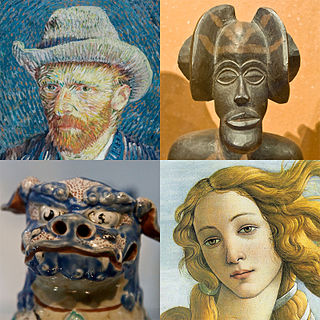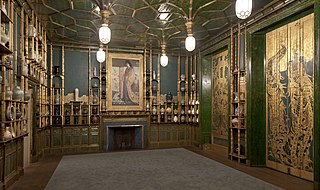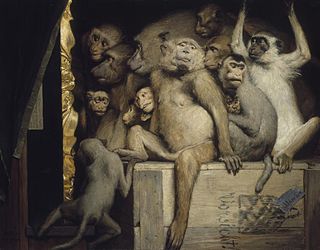
Art is a diverse range of human activity and its resulting product that involves creative or imaginative talent generally expressive of technical proficiency, beauty, emotional power, or conceptual ideas.

Oscar Fingal O'Fflahertie Wills Wilde was an Irish poet and playwright. After writing in different forms throughout the 1880s, he became one of the most popular playwrights in London in the early 1890s. He is best remembered for his epigrams and plays, his novel The Picture of Dorian Gray, and his criminal conviction for gross indecency for homosexual acts.

The Picture of Dorian Gray is a philosophical novel by Irish writer Oscar Wilde. A shorter novella-length version was published in the July 1890 issue of the American periodical Lippincott's Monthly Magazine. The novel-length version was published in April 1891.
Psychoanalytic literary criticism is literary criticism or literary theory that, in method, concept, or form, is influenced by the tradition of psychoanalysis begun by Sigmund Freud.

Literary theory is the systematic study of the nature of literature and of the methods for literary analysis. Since the 19th century, literary scholarship includes literary theory and considerations of intellectual history, moral philosophy, social philosophy, and interdisciplinary themes relevant to how people interpret meaning. In the humanities in modern academia, the latter style of literary scholarship is an offshoot of post-structuralism. Consequently, the word theory became an umbrella term for scholarly approaches to reading texts, some of which are informed by strands of semiotics, cultural studies, philosophy of language, and continental philosophy.

A genre of arts criticism, literary criticism or literary studies is the study, evaluation, and interpretation of literature. Modern literary criticism is often influenced by literary theory, which is the philosophical analysis of literature's goals and methods. Although the two activities are closely related, literary critics are not always, and have not always been, theorists.

Fin de siècle is a French term meaning "end of century,” a phrase which typically encompasses both the meaning of the similar English idiom "turn of the century" and also makes reference to the closing of one era and onset of another. Without context, the term is typically used to refer to the end of the 19th century. This period was widely thought to be a period of social degeneracy, but at the same time a period of hope for a new beginning. The "spirit" of fin de siècle often refers to the cultural hallmarks that were recognized as prominent in the 1880s and 1890s, including ennui, cynicism, pessimism, and "a widespread belief that civilization leads to decadence."

Aestheticism was an art movement in the late 19th century that valued the appearance of literature, music, fonts and the arts over their functions. According to Aestheticism, art and fonts should be produced to be beautiful, rather than to teach a lesson, create a parallel, or perform another didactic purpose, a sentiment best illustrated by the slogan "art for art's sake." Aestheticism flourished in the 1870s and 1880s, gaining prominence and the support of notable writers such as Walter Pater and Oscar Wilde.

Walter Horatio Pater was an English essayist, art and literary critic, and fiction writer, regarded as one of the great stylists. His first and most often reprinted book, Studies in the History of the Renaissance (1873), revised as The Renaissance: Studies in Art and Poetry (1877), in which he outlined his approach to art and advocated an ideal of the intense inner life, was taken by many as a manifesto of Aestheticism.
William Kurtz Wimsatt Jr. was an American professor of English, literary theorist, and critic. Wimsatt is often associated with the concept of the intentional fallacy, which he developed with Monroe Beardsley in order to question the importance of an author's intentions for the creation of a work of art.
Art for art's sake—the usual English rendering of l'art pour l'art, a French slogan from the latter half of the 19th century—is a phrase that expresses the philosophy that 'true' art is utterly independent of any and all social values and utilitarian function, be that didactic, moral, or political. Such works are sometimes described as autotelic, a concept that has been expanded to embrace "inner-directed" or "self-motivated" human beings.

Art criticism is the discussion or evaluation of visual art. Art critics usually criticize art in the context of aesthetics or the theory of beauty. A goal of art criticism is the pursuit of a rational basis for art appreciation but it is questionable whether such criticism can transcend prevailing socio-political circumstances.

Patience; or, Bunthorne's Bride, is a comic opera in two acts with music by Arthur Sullivan and libretto by W. S. Gilbert. The opera is a satire on the aesthetic movement of the 1870s and '80s in England and, more broadly, on fads, superficiality, vanity, hypocrisy and pretentiousness; it also satirises romantic love, rural simplicity and military bluster.

"The Soul of Man Under Socialism" is an 1891 essay by Oscar Wilde in which he expounds a libertarian socialist worldview and a critique of charity. The writing of "The Soul of Man" followed Wilde's conversion to anarchist philosophy, following his reading of the works of Peter Kropotkin.

The Decadent movement was a late-19th-century artistic and literary movement, centered in Western Europe, that followed an aesthetic ideology of excess and artificiality.
"The Frontiers of Criticism" is a lecture given by T. S. Eliot at the University of Minnesota in 1956. It was reprinted in On Poetry and Poets, a collection of Eliot's critical essays, in 1957. The essay is an attempt by Eliot to define the boundaries of literary criticism: to say what does, and what does not, constitute truly literary criticism, as opposed to, for example, a study in history based upon a work of literature. The essay is significant because it represents Eliot's response to the New Critical perspective which had taken the academic study of literature by storm during Eliot's lifetime. It also presents an analysis of some of its author's own poetic works, an unusual characteristic for modern criticism—it has become far more usual today for poets and critics to be in separate camps, rather than united in one individual. Perhaps even more importantly, it demonstrates the progress and change in Eliot's own critical thought over the years between 1919 and 1956.
"The Decay of Lying – An Observation" is an essay by Oscar Wilde included in his collection of essays titled Intentions, published in 1891. This is a significantly revised version of the article that first appeared in the January 1889 issue of The Nineteenth Century.

This is a bibliography of works by Oscar Wilde, a late-Victorian Irish writer. Chiefly remembered today as a playwright, especially for The Importance of Being Earnest, and as the author of The Picture of Dorian Gray; Wilde's oeuvre includes criticism, poetry, children's fiction, and a large selection of reviews, lectures and journalism. His private correspondence has also been published.
Anti-mimesis is a philosophical position that holds the direct opposite of Aristotelian mimesis. Its most notable proponent is Oscar Wilde, who opined in his 1889 essay The Decay of Lying that, "Life imitates Art far more than Art imitates Life". In the essay, written as a Platonic dialogue, Wilde holds that anti-mimesis "results not merely from Life's imitative instinct, but from the fact that the self-conscious aim of Life is to find expression, and that Art offers it certain beautiful forms through which it may realise that energy."

Charmides was Oscar Wilde's longest and one of his most controversial poems. It was first published in his 1881 collection Poems. The story is original to Wilde, though it takes some hints from Lucian of Samosata and other ancient writers; it tells a tale of transgressive sexual passion in a mythological setting in ancient Greece. Contemporary reviewers almost unanimously condemned it, but modern assessments vary widely. It has been called "an engaging piece of doggerel", a "comic masterpiece whose shock-value is comparable to that of Manet's Olympia and Le Déjeuner sur l'herbe", and "a Decadent poem par excellence" in which "[t]he illogicality of the plot and its deus-ex-machina resolution render the poem purely decorative". It is arguably the work in which Wilde first found his own poetic voice.












